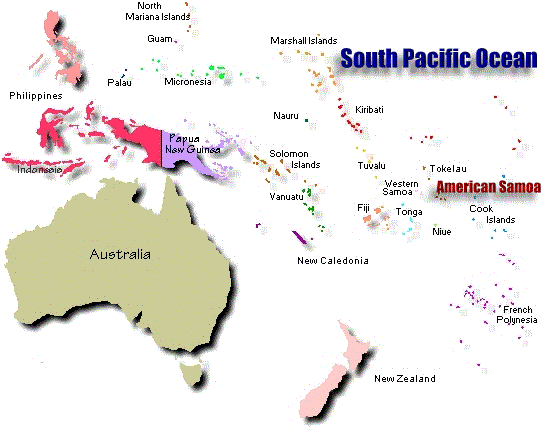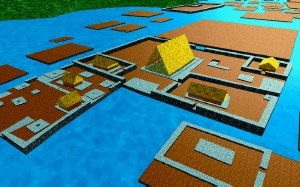Ancient Polynesia
Looking back from the anceint time since we (Polynesians) arrived from Asia to Pacific,Philippines,and to other part of the world and so to America.Are the Polynesians going to be the same like the past where all the elder live together in small and dirty village?Will all of our knowledge end with them??Much has been lost...Because our unity and identity change dramatically ever since European discovery of our land.
Tears among saddness,I look into the eyes of our elders,deep inside my heart --I question myself,who are we (Polynesians)?Why are we here?Or isn't we are still on our journey to find out what is within us,the Polynesian people...we have a strong mind beyond most other people.But what will we do with this gift from God??
I took a deep breath and exhaled,looking down at my feet and I saw tears that managed to slip from my eyes.I feel SAD myself,because I don't know what will happen to our people in the next 50 years??
The hope that Polynesian people would be united is slim.This could be the END of Polynesia and it's people when the elders and leader is GONE.As a result,Polynesians could be a sad history of a
people.

Samoa and the rest of Polynesia,once was the perfect paradise.Once we spoke a language that in ancient times covered more area of earth than any other language.Consider this,ancient Egyptian "Ra"-sun;Polynesian "araw,ra,la".From Madagaskar to Easter Island,from Taiwan through the Philippines was the great Malayo-Polynesian empire.The only problem was,we never joined together.Indonesia was taken over
by the Muslims and later by the Dutch;Philippines was taken over by the Spanish (which saved them from Muslim rule);New Zealand and many other small island groups were controled by the
British or French.Through all of this,much of our culture and language was lost;that is why Filipinos say "kumusta ka" (como estas) instead of "o faapefea mai oe?" (this was original way to say "how are you").
Now there is increasing concern for the fate of Polynesian people;I am not saying that all the Western influence is bad,but unfortunately
we trade the best of the East for the worst of the West.I am glad that we were taught about the one true God,
if not for European influence,we would still be worshipping "anitos".Samoa,Tonga,Pampanga and a few other places seem to be the only ones wanting to preserve what is left.Pamagkulit,the original writing system has been almost forgotten;I am
thankful that my mother taught me this,it gives me a link to the "fa'a matua" (ancestoral way).Polynesians are becoming much more strict concerning marriage among other people and other things relating to preserving the old ways.
I can not agree with all the things that my parents would want for me,I must respect them,but I believe that sometimes we must compromise.But our culture and language is one that we should be
proud of.I would certainly want my children to be able to speak Kapampangan or Samoan,but not ignoring the fact that they live in the modern world.I have a great responsibility to carry on what my parents taught me about the old ways and where we came from.My parents were born in the 1930's,and life is so much different now,and like others in my age group;we must carry our knowledge to the next generation.Like most other people,I have concern for the future;who will take care of me when I am old,who will I care for.So many problems face modern Polynesians;racism,alcoholism,and poverty,just to name a few.Many Polynesians who consider sincere love to not exist anymore have gone to the opposite extreme of violence.But this way of thinking will only insure that we will NOT survive another generation.Whether our paradise is lost depends on us.
Now some history.
Agpang king likas-likas dang istorya ding dai nang Balagtas,ngara, king ating metung a prinsiping ibat
Java a menuknangan kambe ring kayang bulud,o grupu,king pampang ning ilug (Pampanga River),ban karin
de pagmulan ing karelang imperio.King uli niti,atin yang makasdan a istorya i Padre Francisco Colin, nung nu
ketang ika 17-siglo (17th Century),atagpuan ne ing metung a maglakbe Kapampangan a ibat Sumatra,at
miparas la king libis ning damuman.At mipabusal la karing taung magsalitang malino Kapampangan.
Makapiblas lang matuang usung barung Kapampangan a susulud da ketang minunang panaun.Ketang
pamangutang da, anti keni ing sinabi nitang matua:"Ikayu (Pampangos) supling da kayu ding memalen a
mebating.Meko la keti kanita, ban manuknangan la king aliwang labuad, at manibat na kanita, e no mibalita."
Ing makayagkat mu namang pansin ya ing lenguahe a bilang magpatutu.Tutung dakal ing salita king
Mauling-Aslagan ning ASIA a gagamitan ding Indonesia king pamilyang Malayo-Polynesian.Ing Malay ya ing
Pambansa rang salita:ning Brunei,Singapore,Malaysia,Indonesia,at Samoa,ampon ding atlu nang Probinsya ning
Thailand.Ing Malay ya ing salita rang gagamitan ding 75% ning kabilugan a ASEAN.Dekayanan dong 40%
ding Pilipino king vocabularyo ra.Dakal la ring amanu king Malay a e mayayakit king Tagalug,at karing aliwa
pang salitang Pilipino,dapot atilu king salitang Kapampangan. Milista tamung mapilan a amanung amana ring
Kapampangan karing Bahasa Malay/Indonesia,at Samoanu:
Bahasa Malay Kapampangan Samoan Igilisi
Mata Mata Mata Eye
Udang Ulang Ula Shrimp
Minum Minum Inu Drink
Jalan Dalan Ala Road
Niyok Niyug Niu Coconut
Ulu Ulu Ulu Head
Api Api Afi Fire
Aku Aku A'u I
Itu Ita Lea This
Sepulun Apulu Sefulu Ten
Lima Lima Lima Five
Some information provided from "Ing Susi",faafetai tele lava.This section by Pablo

Nan Madol-Pohnpei
Nan Madol reportedly was the ceremonial and political seat of the Sau Deleur dynasty which united Pohnpei's estimated 25,000 people in late prehistoric times.Oral history as well as archaeological evidence substantiate Nan Madol's position as the island's preeminent political and religious center up until the A.D. 1500s when the centralized system collapsed.Today Nan Madol forms an archaeological district covering more than 18 sq. km and includes the stone architecture built up on a coral reef flat along the shore of Temwen Island (Nan Madol Central), several other artificial islets, and the adjacent Pohnpei main island coastline.The site core with its stone walls encloses an area approximately 1.5 km long by 0.5 km wide and it contains nearly 100 artificial islets--stone and coral fill platforms--bordered by tidal canals.It estimated that between 500,000 and 750,000 metric tons of building material were transported from varying distances into the site.
Research provides basic information on Nan Madol and more than 200 other Pohnpeian sites useful for placing it in an island-wide context.Individual platforms and large artificial islets mapped in my projects illustrate complex distributions of surface architecture, artifacts, and food refuse.Excavations designed to reveal architectural building stages and style changes verify more than 2000 years of occupation and possibly a 1000 year span of major construction activity from A.D. 500 to 1500.
In 1986 three field seasons were planned to establish the overall Nan Madol developmental sequence and to clarify its relationships to other Pohnpei sites. The project has been supported by the National Endowment for the Humanities, private matching funds,and substantial donated field time by myself and other participants.The Historic Preservation Offices of Pohnpei State and the Federated States of Micronesia have been centrally involved in these projects.
Portable artifacts recovered at Nan Madol number several thousand and include shell tools and ornaments, pottery, and stone tools.Food remains that provide a basis for dietary and activity pattern reconstructions have been collected from a variety of contexts.Nan Madol ceramic collections show considerable variability suggestive of major stylistic changes and non-local production sources typical of chiefly exchange.The results of islet mapping and testing provide chronological control over intra-site stylistic and functional variation in ceramics and shell artifacts. Representative samples of the site's major architectural clusters and of other sites which represent different functional and temporal variations are available.Patterning studies indicate a correlation between high status remains (artifacts, food remains, and architecture) and certain islets.Computer-generated artifact point plots have been useful and isometric projections of several islets and architectural features provide detailed reconstructions. Underwater archaeological survey and provenance studies of building materials are also being completed.A good overview of all Nan Madol islet types and locations, a significant sample of subsurface deposits, detailed maps and reconstructions of more than 20 islets, and good controls over the architectural buildup at the site are available.
Questions remain about Nan Madol's purpose and context within the broader Pohnpeian sociopolitical system, and thus a comprehensive assessment and integration of available information is essential.I am now working on new data related to prehistoric artifact and building sequences, analyzing architectural features with their associated artifact surface distributions, and relating the development of this unique site complex to long-term cultural change and structural evolution on Pohnpei and on Pacific islands in general.


